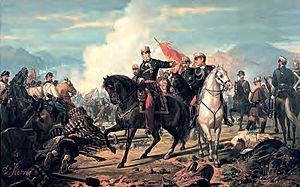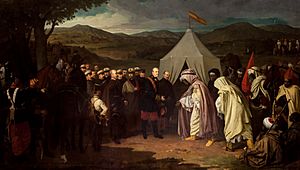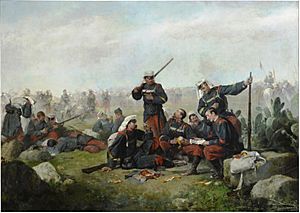Hispano-Moroccan War (1859–1860) facts for kids
Quick facts for kids Hispano-Moroccan War |
|||||||
|---|---|---|---|---|---|---|---|
 Mariano Fortuny's depiction of the Battle of Tetuan, oil on canvas (MNAC). |
|||||||
|
|||||||
| Belligerents | |||||||
| Commanders and leaders | |||||||
| Strength | |||||||
| Expeditionary Army: Spanish Armada: Week 6 Reinforcements |
Cherifian Army: |
||||||
| Casualties and losses | |||||||
|
|||||||
|
|
|||||||
The Hispano-Moroccan War was a conflict between Spain and Morocco. It is also called the Spanish–Moroccan War or the War of Africa in Spain. The war lasted from October 22, 1859, to April 26, 1860. It started because of disagreements over the borders of the Spanish city of Ceuta. The fighting took place in northern Morocco. Spain won the war, and Morocco agreed to a peace treaty called the Treaty of Wad-Ras.
Contents
Why the War Started
Throughout the 1800s, Morocco faced several military defeats from European countries. One important event was the Franco-Moroccan War in 1844. In 1856, Morocco signed a treaty with Britain. This treaty changed customs duties and ended royal monopolies.
Spanish cities like Ceuta and Melilla in North Africa often faced attacks. These attacks came from local tribes, especially in 1844, 1845, and 1848. These ongoing attacks were a main reason for the war.
The War Begins
Spain decided to go to war because of the constant attacks on its settlements. They tried to negotiate with the Moroccan Sultan, Abd al-Rahman, but it was difficult. The Sultan died during these talks. His brother, Muhammad IV, took his place.
On October 22, 1859, Spain officially declared war. This decision was strongly supported by Leopoldo O'Donnell, a Spanish general. The Spanish parliament agreed to the war unanimously.
Spanish Forces
Spain sent a large army from Algeciras. This army included about 45,000 soldiers. They also had 3,000 mules and horses and 78 artillery pieces. The Spanish navy supported them with 24 warships and 11 transport ships.
The main goals for Spain were to capture the city of Tetouan and the port of Tangier.
Key Battles and Advances
On December 17, fighting began when Spanish forces took over the Sierra de Bullones. Two days later, they captured the Serrallo Palace. On December 21, General O'Donnell led troops who landed in Ceuta. By December 25, the Spanish army had secured their positions. They were ready to advance towards Tetouan.
On January 1, 1860, General Prim led an attack. Spanish forces pushed forward with support from the navy. Skirmishes continued until January 31. On that day, a Moroccan attack was stopped.
General O'Donnell then began the march towards Tetouan. He had support from Catalan volunteers. Spanish artillery was very effective, breaking Moroccan lines. The remaining Moroccan soldiers retreated into Tetouan. The city fell to the Spanish on February 6.

The Spanish entered Tetouan on February 3, 1860. They bombarded the city for two days. This caused a lot of disorder. Local tribesmen entered the city and looted it. A Moroccan historian, Ahmad ibn Khalid al-Nasiri, described the chaos:
A tumult broke out in the town,... the hand of the mob stretched out to plunder, and even [normal] people took off the cloak of decency.... People of the Jabal, and the Arabs, and the riffraff began to pillage and steal; they broke down the doors of the houses and the shops.... keeping at it the whole night until the morning
On February 5, the Spanish fully entered the city. This marked the end of the battle and the war.
After the War

After a 32-day ceasefire, the Treaty of Wad-Ras was signed on April 26, 1860. This treaty, also known as the Peace of Tetouan, had several important points:
- Spain's presence in Ceuta and Melilla would be permanent.
- Tribal raids on these cities had to stop.
- Morocco recognized Spanish control over the Chafarinas Islands.
- Spain gained control of Santa Cruz de la Mar Pequeña (later known as Ifni). This area was for a fishing post.
- Christian missionaries were allowed to build a church in Tetouan.
- Spain would control Tetouan until Morocco paid war damages.
Morocco had to pay 20 million duros to Spain. They got some of this money from a loan from the British. Once the payment was made, General O'Donnell withdrew his troops from Tetouan.
Sources
- (World History at KMLA)
- Moroccan War 1859-1860
- "A History of Modern Morocco" pages 24–25 Susan Gilson Miller, Cambridge University Press 2013
See also
 In Spanish: Guerra de África para niños
In Spanish: Guerra de África para niños


